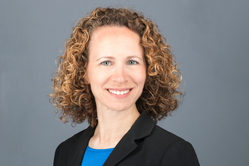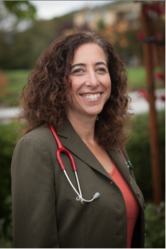Last week, three pediatricians — with a combined experience of 15 years integrating ACEs science into their practices — reflected on the urgency they felt several years ago that prompted them to begin screening patients for childhood adversity and resilience when there was practically no guidance at all. Along their journey, they accumulated a list of lessons learned for other pediatricians and family clinics to use.
The three pediatricians participated in the ACEs Connection webinar, “Integrating ACEs science into pediatrics: Early adopters share lessons from the field,” which was co-sponsored with the California Campaign to Counter Childhood Adversity. It took place on October 17, 2019. They were Dr. Deirdre Bernard-Pearl, a pediatrician and the medical director of the Santa Rosa (CA) Community Health Pediatric Campus and the Elsie Allen Teen Campus; Dr. R.J. Gillespie, The Children’s Clinic in Portland, OR; and Dr. Ariane Marie-Mitchell, a professor at Loma Linda University.
Why do this webinar now? California is preparing to roll out training and reimbursement for doctors who choose to screen their pediatric and adult patients who are part of its Medicaid program. It’s the first state in the nation to take on this goal of potentially more than 54,000 providers screening 5.3 million pediatric patients. Many states are watching how the state, the pediatric community, and community organizations that provide services grapple with the transition.
ACEs is a term that comes from a landmark study that showed how widespread childhood adversity is. The CDC-Kaiser Permanente Adverse Childhood Experience Study of more than 17,000 adults, which was first published in 1998, linked 10 types of childhood adversity — such as living with a parent who is mentally ill, has abused alcohol or is emotionally abusive — to the adult onset of chronic disease, mental illness, violence and being a victim of violence. Many other types of ACEs— including racism, bullying, a father being abused, and community violence — have been added to subsequent ACE surveys.
The ACE Study found that the higher someone’s ACE score — the more types of childhood adversity a person experienced — the higher their risk of social, economic, health and civic consequences. The study found that most people (64%) have at least one ACE; 12% of the population has an ACE score of 4 or higher. Having an ACE score of 4 nearly doubles the risk of heart disease and cancer. It increases the likelihood of becoming an alcoholic by 700 percent and the risk of attempted suicide by 1200 percent. (For more information about how this works and about the full complement of ACEs science, go to ACEs Science 101. To calculate your ACE and resilience scores, go to: Got Your ACE Score?)

“We don’t have to wait for adulthood to see the impact of ACEs,” said Marie-Mitchell. “Our patients are telling us about adversity in their lives and we have seen those reports associated with health care utilization, health outcomes and biomarkers of toxic stress." Reflecting back on what led her to do ACEs screenings, she said: "There were clearly differences in risk in the patients I was seeing, but inherent to well child visits is the “one-size-fits-all” medical model.” (See her attached slides below.)
“Our biggest desire was to try and think about how to prevent ACEs from happening in the first place,” said Gillespie. “Obviously that’s a very heavy lift. When thinking about how we would do that, we turned our attention to the parent’s ACEs, knowing that there are some correlations between parent ACEs and kids’ eventual ACEs. And our thought was if we could identify parents with ACEs at greatest risk and bring their trauma history out of the closet, figure out a way to support them when they felt most challenged, without them feeling like they’re being judged, then potentially we would be able to create a new cycle of healthier parenting.”

In fact, research conducted by Gillespie and his colleagues reinforces the association of parental ACEs and their impact on children. “We found a clear correlation between parents’ ACEs and kids’ developmental screening results by age 2,” he said. “With each subsequent ACE, that added an 18 percent risk in failing the developmental screen at age 2,” he said. (See his attached slides below.)
To break down their initial thinking further about screening parents, explained Gillespie, he and colleagues thought about some of the high-stress times of parenting, such as if a baby suffering from colic cries uncontrollably, or toilet training a child, or having a toddler hitting and biting while throwing a tantrum — all times when an unsupported parent with trauma could be triggered into fight, flight or freeze. And they wondered, “Can we prepare parents to be more supportive in a different way and recognize how their own trauma histories may impact how they respond to their child’s behavior?”
To integrate ACEs screening, the pediatricians had to figure out what patients and their families would accept. With input from patients, Marie-Mitchell said, she and colleagues developed and fine-tuned a tool for ACEs screening they call the Whole Child Assessment (WCA). The initial feedback they received from patients, said Marie-Mitchell, was “these questions are important to know, but other people won’t answer these questions truthfully.”
What Marie-Mitchell and her colleagues settled on — after three years of feedback and several iterations — is a questionnaire that incorporates ACE questions along with questions culled from another form required by California. That lessens form fatigue and cuts down the time suck for patients and providers alike. (In this story about the WCA, Marie-Mitchell says that adding “unsure” as a response to questions, opened up an opportunity to have a conversation with families and learn more.)

The Santa Rosa Community Health Pediatric Campus created and consulted with a parent advisory board, said Dr. Deirdre Bernard-Pearl. “The parents said they want someone kind and caring to give them a survey and they want us to explain that everyone fills out a survey,” she said. “They also wanted the survey given to them in the exam room and they wanted someone with whom they had a relationship to go over the survey with them.” The clinic followed all of their suggestions. (Read more about it in this story here.)
Establishing and building the relationship between provider and patient was also at the heart of the process of unearthing patients’ trauma and finding solutions: “ACEs is about broken relationships. But we can let the healing begin by letting both child and caregiver know that we will listen and we will care,” said Bernard-Pearl.
Gillespie agreed. “For me the biggest lesson of an ACEs assessment is not to force a disclosure but to create a culture change in practice. So, for me the idea that my families can come to me with any concern or problem that they’re having is the end goal, that my office is a safe place for parents to address whatever issues they’re having.”
And discussion is not just about problems, said Gillespie. “Resilience is part of the conversation as well and is something that can be learned and improved upon and modeled to parents and children.”
Speakers were also clear that how they deal with positive results on an ACEs screen is nuanced and different than a typical medical model. “What we found is that this approach doesn’t apply so well to ACEs,” said Bernard-Pearl. Many people with ACEs don’t want an intervention. Maybe they’re not ready for something. Or maybe they don’t need anything. It’s been a very humbling process where we’ve learned to make a shift from the medical model of telling people with positive screens what to do, to being much more humble and asking them what is it that they want or need.” (See her attached slides below.)
Lessons learned from early adopters:
• The choice of the screening tool has to be acceptable to both families and staff.
• The screening tool must be time efficient
• Start implementation small and think big. Start with the providers who are really the most interested. They can test it out and share what they learned with the rest of the staff.
• Train your entire staff in trauma-informed practices.
• Thank the patient for their honesty and vulnerability, which validates to them the importance of their story.
• Workflow and time management. ACEs and resilience screening is not a one-visit experience. If a patient has concerns you can ask if they want to schedule a follow-up visit.
• Room teens separately from their parents when giving them ACE surveys.
• Because of the sensitivity of the ACE survey, give patients the surveys in the privacy of an exam room.
Several questions came in towards the end of the webinar that our speakers answered below:
Based on your experience and knowing that California is moving forward with universal ACEs screening in its pediatric patients, what do you think it will take for this state-wide effort to be successful?
Dr. Gillespie: Generally, I think it’s important to remember that ACE screening isn’t done in isolation – but in the context of a comprehensive screening program that looks at development, maternal depression, mental health, and so forth. Because of the increasing volume of screens that are being recommended, practice-based support and coaching should be made available to practices to help ensure success state-wide. This includes training practices in trauma-informed care, learning about community resources, and understanding basic workflow breakdown and implementation.
Dr. Marie-Mitchell: In order to facilitate widespread adoption of ACEs screening along with utilization that informs the delivery of health care, pediatricians need to be able to choose an ACEs screening tool that is acceptable and feasible for their practice and patient population. Pediatricians also need education about why screening for ACEs is important for the delivery of health care, and how to counsel families about ACEs and resilience.
Do you have any suggestions for parenting programs that are good to use for referrals?
Here are examples of programs recommended by the webinar speakers. Not all programs are available everywhere. Dr. Gillespie said that organizations such as Help Me Grow, which has chapters around the country, is a good resource for finding out what’s available locally. Suggested programs included:
Healthy Steps
Circle of Security
Nurturing Parenting program
Triple P Parenting
How do you handle disclosures of domestic violence?
Dr. Bernard-Pearl: When a child – even a young infant – witnesses violence in the home, it should be reported to CPS. When adults are experiencing Intimate partner violence, they often feel trapped and emotionally manipulated and controlled as well. It is very important to give them information about getting support for themselves and help them think about who their allies (family members, friends) are for support. I also recommend that they call 911 after any future episode.
Dr. Gillespie: That depends. Some states mandate reporting intimate partner violence (IPV) to child protective services. So that is the first consideration – has a report already been made? For me, the next steps are assessing family / parent / child safety and providing resources based on that, and then referring to community support agencies depending on what needs the family has identified. Our Defending Childhood Initiative (a county-based anti-violence program) has lists of resources that I keep on my desktop for when these cases come up – then I can look through it for resources like shelters, legal aid, support groups, mental health providers.
Dr. Marie-Mitchell: We respond to all positive screens for ACEs with an open-ended question, “Can you tell me more about that?” Depending upon what more is said, we provide education or resources. In the case of domestic violence, key counseling includes emphasizing: 1) There is no excuse for abuse of any kind; 2) The cycle of violence repeats; and 3) Help is available when you’re ready.
I'm the Healthcare Access Specialist for Puerto Rico Primary Care Association. We work with Federally Qualified Health Centers. My interest is to introduce ACEs [screening] and implement trauma-informed care. Do you think that knowing about protective factors would be more important to know than the ACE score?
Dr. Bernard-Pearl: I absolutely agree that assessing protective factors is a very empowering and positive focus for a trauma-informed care program. I think it is a great idea to assess both ACEs and protective factors if you have the capacity to do this.
Dr. Gillespie: I think the conversation should be balanced – that it should include both. I believe that families who have experienced trauma generally need more help with resilience building (one of my colleagues described it as: “Children who have been exposed to violence need developmental promotion times ten.”), which requires knowing which families experienced trauma so that we can know who needs the additional support. I’ve been examining whether resilience scores are more predictive than ACE scores for the developmental outcomes, but that data isn’t finished yet. I do have suspicion that a high ACE, high resilience family will be lower risk than a low ACE, low resilience family – so I think the resilience information may help to modify our understanding of risk at some point.
Dr. Marie-Mitchell: I would say that it is important to know about the presence or absence of specific ACEs, and it is important to counsel on protective factors in general. One is not more important than the other.
We schedule well child [visits] for 30 min but it is double booked with a sick visit leaving me only 15 minutes. How does that work with the WCA and having enough rooms for teens to fill form before?
Dr. Marie-Mitchell: We have the front desk hand out the WCA to the teen when they check in. If the WCA is not complete when the doctor arrives, then the doctor starts off with interviewing the parent while the teen completes the questionnaire. We find that using the WCA to guide the history allows us to more efficient, cover the most pertinent topics.
How did you decide what age group to screen first for ACEs?
Dr. Marie-Mitchell: Most pediatric practices have the highest volume for age 0-4 years old. We chose to try out screening for ACEs in age 5-11 years old because the visit volume was lower, but the instrument was still completed by the parent and so relevant to age 0-11. We now screen all ages.
To learn more tips about how these doctors transformed their practices, what Dr. Gillespie’s data shows, what they wish they had done differently and what they’re doing now, you can view the recorded webinar by clicking the arrow in the top of the article or clicking here.




Comments (0)